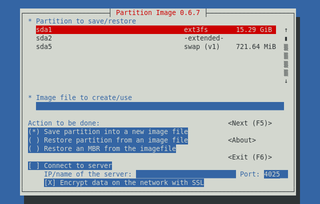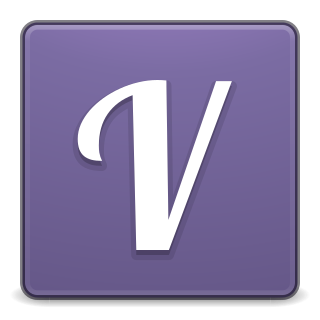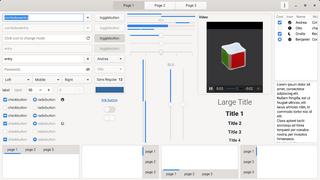See also
- R (programming language) (The R statistical programming language)
| Developer(s) | Michael Lawrence and Duncan Temple Lang |
|---|---|
| Stable release | 2.20.36 [1] / 8 March 2019 |
| Operating system | Cross-platform |
| Platform | Cross-platform |
| Type | widget toolkit |
| License | GPL |
| Website | www.ggobi.org/rgtk2 |
RGtk2 is a set of R wrappers for the GTK+ graphical user interface library. RGtk2 is free software and licensed under the GPL.
The code below will produce a 200x200 pixel window with the words "Hello World" inside.
library(RGtk2)createWindow<-function(){window<-gtkWindow()label<-gtkLabel("Hello World")window$add(label)}createWindow()gtk.main()RGtk2 has been used in a number of notable applications, some examples:

Gambas is the name of an object-oriented dialect of the BASIC programming language, as well as the integrated development environment that accompanies it. Designed to run on Linux and other Unix-like computer operating systems, its name is a recursive acronym for Gambas Almost Means Basic. Gambas is also the word for prawns in the Spanish, French, and Portuguese languages, from which the project's logos are derived.

R is a programming language for statistical computing and graphics supported by the R Core Team and the R Foundation for Statistical Computing. Created by statisticians Ross Ihaka and Robert Gentleman, R is used among data miners, bioinformaticians and statisticians for data analysis and developing statistical software. Users have created packages to augment the functions of the R language.

The Standard Widget Toolkit (SWT) is a graphical widget toolkit for use with the Java platform. It was originally developed by Stephen Northover at IBM and is now maintained by the Eclipse Foundation in tandem with the Eclipse IDE. It is an alternative to the Abstract Window Toolkit (AWT) and Swing Java graphical user interface (GUI) toolkits provided by Sun Microsystems as part of the Java Platform, Standard Edition (J2SE).
Fast Light Toolkit is a cross-platform widget library for graphical user interfaces (GUIs), developed by Bill Spitzak and others. Made to accommodate 3D graphics programming, it has an interface to OpenGL, but it is also suitable for general GUI programming.

PyGTK is a set of Python wrappers for the GTK graphical user interface library. PyGTK is free software and licensed under the LGPL. It is analogous to PyQt/PySide and wxPython, the Python wrappers for Qt and wxWidgets, respectively. Its original author is GNOME developer James Henstridge. There are six people in the core development team, with various other people who have submitted patches and bug reports. PyGTK has been selected as the environment of choice for applications running on One Laptop Per Child systems.
The FOX toolkit is an open-source, cross-platform widget toolkit, i.e. a library of basic elements for building a graphical user interface (GUI). FOX stands for Free Objects for X.
PHP-GTK is a set of language bindings for PHP which allow GTK GUI applications to be written in PHP. PHP-GTK provides an object-oriented interface to GTK classes and functions. While PHP-GTK partially supports GTK2, GTK3 is not supported at all.
gtkmm is the official C++ interface for the popular GUI library GTK. gtkmm is free software distributed under the GNU Lesser General Public License (LGPL).
Gtk2-Perl is a set of wrappers for the Perl programming language around the GTK and further GNOME libraries. Gtk-Perl is free and open-source software licensed under the GNU Lesser General Public License (LGPL) version 2.1. Developers and interested parties can usually be found on the IRC channel #gtk-perl on irc.gnome.org.

Newt is a programming library for color text mode, widget-based user interfaces. Newt can be used to add stacked windows, entry widgets, checkboxes, radio buttons, labels, plain text fields, scrollbars, etc., to text user interfaces. This package also contains the shared library needed by programs built with newt, as well as an application whiptail, which provides the most commonly used features of dialog. Newt is based on the slang library. It abbreviates from Not Erik's Windowing Toolkit.
A software repository, or repo for short, is a storage location for software packages. Often a table of contents is also stored, along with metadata. A software repository is typically managed by source control or repository managers. Package managers allow automatically installing and updating repositories.

Vala is an object-oriented programming language with a self-hosting compiler that generates C code and uses the GObject system.
Clutter is a discontinued GObject-based graphics library for creating hardware-accelerated user interfaces. Clutter is an OpenGL-based 'interactive canvas' library and does not contain any graphical control elements. It relies upon OpenGL (1.4+) or OpenGL ES for rendering,. It also supports media playback using GStreamer and 2D graphics rendering using Cairo.

Ultimate++, also known as Ultimatepp, U++ or Upp - is a C++ rapid application development framework which aims to reduce the code complexity of typical desktop applications by extensively exploiting C++ features. Programs created with it can work on multiple operating systems and hardware architectures without the need to write platform specific code.

GTK is a free and open-source cross-platform widget toolkit for creating graphical user interfaces (GUIs). It is licensed under the terms of the GNU Lesser General Public License, allowing both free and proprietary software to use it. It is one of the most popular toolkits for the Wayland and X11 windowing systems.
PySide is a Python binding of the cross-platform GUI toolkit Qt developed by The Qt Company, as part of the Qt for Python project. It is one of the alternatives to the standard library package Tkinter. Like Qt, PySide is free software. PySide supports Linux/X11, macOS, and Microsoft Windows.
Seed is a JavaScript interpreter and a library of the GNOME project to create standalone applications in JavaScript. It uses the JavaScript engine JavaScriptCore of the WebKit project. It is possible to easily create modules in C.

Nim is a general-purpose, multi-paradigm, statically typed, compiled systems programming language, designed and developed by a team around Andreas Rumpf. Nim is designed to be "efficient, expressive, and elegant", supporting metaprogramming, functional, message passing, procedural, and object-oriented programming styles by providing several features such as compile time code generation, algebraic data types, a foreign function interface (FFI) with C, C++, Objective-C, and JavaScript, and supporting compiling to those same languages.

R packages are extensions to the R statistical programming language. R packages contain code, data, and documentation in a standardised collection format that can be installed by users of R, typically via a centralised software repository such as CRAN. The large number of packages available for R, and the ease of installing and using them, has been cited as a major factor driving the widespread adoption of the language in data science.